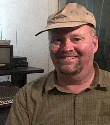|
|
This topic comprises 2 pages: 1 2
|
|
Author
|
Topic: How to best present "Spellbound"?
|
|
|
|
|
|
|
|
|
|
|
|
|
|
|
Randy Stankey
Film God

Posts: 6539
From: Erie, Pennsylvania
Registered: Jun 99
|
 posted 09-28-2003 11:58 AM
posted 09-28-2003 11:58 AM




The problem with installing a traveller is that there's not a lot of room between pipes. They are on (I think) 8" centers. The screen is on lineset #5. The masking is on pipe #4. Then, pipe #3 is "First Electric". #2 is "Main Rag". #1 is "Main Valence and Border". That puts the screen 48" upstage of the plaster line. The biggest problem is that "First Elec." has lights on it, making is slightly wider than the 16" fly space given it. You have to have room to swivel the fixtures yet keep the hot lights away from the curtains, lest they get "toasted". Tying the curtains to the pipe is the lowest profile we can have. This is a big PITA but it's the best solution we have come up with. We might possibly be able to come up with enough $$ to buy a low profile traveller track but we'd probably have to move the screen back one pipe to make fly space for the curtain.
Moving the screen upstage brings on another set of problems: Line #6 is the orchestra shell. That's 800 lbs. of wood and steel to move. The screen frame is iron pipe fashioned out of "Kee-Klamps". There's another couple-few hundred pounds of weight to move there. All those pipes would have to be reweighted when the goods are moved upstage. We don't have the manpower. There's just me and the Production Manager. The rest of the labor force is Work Study students. (Not a reliable workforce for "heavy stuff" like that.) Assuming all of that can be done, we have to account for the screen being moved 8" farther away from the projector. The image size would increase. New lenses would have to be purchased. New apretures would have to be cut. We're in a cluster fuck situation as it is. I'm going to have to live with things as they stand for a while. ![[bs]](graemlins/bs.gif)
We DO have an Academy lens/aperture set. We are the only place in town (within at least 100 miles) that even has a set. Not even the old Warner Theatre has them. I know. I'm the last guy to run those machines. We will be using Academy later on this year to present Metropolis. I want to see that movie! ![[Smile]](smile.gif)
Our projector is an older model Simplex. PR-1003, to be exact. It has no turret but the "lens shifter" for old style Cinemascope movies is still intact and working. I have it set up so that I can shift off center images back onto the screen. I have my workstudies check the projector every reel. Most of them don't know what a cue dot really means, except that they have to get up from their seats in the back row of the balcony and go check the projector! ![[Wink]](wink.gif) I'll make sure when they go to check the film path, focus and sound that they also check the lens shift. So, Christopher, thanks for the tip! I'll make sure when they go to check the film path, focus and sound that they also check the lens shift. So, Christopher, thanks for the tip!
You guys don't think I need to put some masking on the window? What if the film is scratched outside the image area but inside the black matted area? Won't that put distracting "squigglies" on the curtain? I thought that taping off the windows would prevent some of that. You all KNOW what condition this film is likely to be in!
| IP: Logged
|
|
|
|
|
|
|
|
|
|
|
|
Frank Angel
Film God

Posts: 5305
From: Brooklyn NY USA
Registered: Dec 1999
|
 posted 09-29-2003 05:57 AM
posted 09-29-2003 05:57 AM





Randy, I feel your pain, buddy. We have the same problem. First Electrics is right behind the screen and the lighting instruments or their gel holders invariably rub against the screen when flying it in or out. We had to attach three "runners" -- 3 inch strips of steel formed into a circle about a foot in diameter -- to the FE pipe. These jutt out just enough to engage the screen frame which then pushs the pipe away as the screen come in or out. I understand that these are standard pipe hardware; you should check them out if they could help in your situation.
Originally the main rag was used as the curtain for movies, but it is a on a manual fly and cannot be motorized except for vast sums of money. After having stage hands miss curtain cues more times than they got it (you have no idea how frustrating it is screaming into a head set, "Curtain go.....curtain GO....CURTAIN GO YOU INCOMPETENT SOB!" only to watch the first 3 minutes of a Merry Melodies cartoon play on the closed curtain), I decided to install a light wight curtain and attached it directly to the screen frame via that Specifine track. It attaches with right-angle brackets which add just enough space for it to fit between the first boader (pipe 1) and the screen frame (pipe 2).
Yes, it is VERY tight in terms of the pipes and the First Electric, but we got it to work....with no help from the Lighting Department, I might add, who's head electrician's solution was "just stop showing movies," or "move the screen to the back wall" -- about 50 feet from the first row of seats. When I responded to those suggestions, I was pulled aside by the GM who told me, "Up yours" is not a professional response to a collegue's position.
Film is always a bastard child in a performing arts hierarchy. You have to fight for every inch of space.
Frank
| IP: Logged
|
|
Scott Norwood
Film God

Posts: 8146
From: Boston, MA. USA (1774.21 miles northeast of Dallas)
Registered: Jun 99
|
 posted 09-29-2003 07:06 AM
posted 09-29-2003 07:06 AM





Out of curiousity, why would the first electric go in front of the screen? That seems unnecessary (why would you want to light the front of the screen from above?) and likely to damage the screen, either due to large lighting instruments that hit the surface or due to heat if someone accidentally turns on the power when the screen is lowered.
At the Columbus (the only place I've shown films that also has full stage rigging, albeit from the 1920s), the first lineset (after the fire curtain) holds the teaser, the second holds the main curtain (which is used as masking), and the third holds the screen. There's another, lighter, curtain a few feet behind the screen (and stage speaker) which stays closed during films in order to avoid reflections from items stored backstage. The speaker itself is not flown, but is on rollers and can be easily moved offstage as needed.
There are also two other screen frames (for 1.33 ratio only) farther back which presumably were used in the silent era when live shows were combined with films in the same program. We've never used them, but I suppose that they might be useful to have for slide lectures or something like that. This theatre doesn't have "electrics" in the modern sense...they just have a half-dozen or so of those striplight/cyc light type things with white/red/blue lights pointing straight down. The lighting capabilities are pretty limited, with just these fixtures, white/red/blue footlights, and white/red/blue border lights, all on a Ward-Leonard resistance board. There are also a few 750w Lekos on the balcony rail controlled by an old (1960s?) 8-channel Century dimmer. Lastly, there's a crappy tungsten-bulb followspot on the balcony, a Brenkert carbon-arc followspot in the original booth that hasn't been used in years (sadly), and a carbon-arc Super Trouper stored backstage that needs a 30 amp circuit which we don't have yet.
| IP: Logged
|
|
|
|
All times are Central (GMT -6:00)
|
This topic comprises 2 pages: 1 2
|
Powered by Infopop Corporation
UBB.classicTM
6.3.1.2
The Film-Tech Forums are designed for various members related to the cinema industry to express their opinions, viewpoints and testimonials on various products, services and events based upon speculation, personal knowledge and factual information through use, therefore all views represented here allow no liability upon the publishers of this web site and the owners of said views assume no liability for any ill will resulting from these postings. The posts made here are for educational as well as entertainment purposes and as such anyone viewing this portion of the website must accept these views as statements of the author of that opinion
and agrees to release the authors from any and all liability.
|

 Home
Home
 Products
Products
 Store
Store
 Forum
Forum
 Warehouse
Warehouse
 Contact Us
Contact Us




 Printer-friendly view of this topic
Printer-friendly view of this topic









![[Roll Eyes]](rolleyes.gif)



![[bs]](graemlins/bs.gif)
![[Smile]](smile.gif)
![[Wink]](wink.gif) I'll make sure when they go to check the film path, focus and sound that they also check the lens shift. So, Christopher, thanks for the tip!
I'll make sure when they go to check the film path, focus and sound that they also check the lens shift. So, Christopher, thanks for the tip!

![[Cool]](cool.gif)



